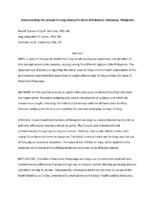| dc.contributor.author | Martinez, Rudolf Cymorr Kirby P. | en |
| dc.contributor.author | Cortez, Augustine Beth | en |
| dc.contributor.author | Contreras, Vanessa Joy | en |
| dc.date.accessioned | 2018-03-02T19:02:37Z | |
| dc.date.available | 2018-03-02T19:02:37Z | |
| dc.date.issued | 3/2/2018 | |
| dc.identifier.uri | http://hdl.handle.net/10755/623747 | |
| dc.description.abstract | <p>AIMS: In spite of the popular belief that <em>Usog</em> produces physical symptoms, the definition of this concept serves to be complex, varying among the different regions in the Philippines. The apparent lack of literature regarding the Aetas’ view on <em>Usog</em> and the health implications of this phenomenon prompted the researchers to explore the concept of <em>Usog</em> among the Aetas of Nabuclod, Pampanga.</p>
<p> </p>
<p>METHODS: In this qualitative study, in-depth interviews were conducted to gather data from the respondents. Purposive sampling was used in the selection of subjects and informed consent was sought. Following the individual interviews with five different Aeta families, thematic analysis was done so as to identify the common emerging concept of <em>Usog</em>.</p>
<p> </p>
<p>FINDINGS: It was found that the Aetas of Nabuclod see <em>Usog</em> as a transmittable mystical force primarily inflicted by humans and not by spirits. This force is said to be transferred unintentionally through eye or physical contact. Similarly, this usually affects infants, with crying fits as the most common symptom. The Aetas’ primary treatment for <em>Usog</em> was the use of Amyong as incense or decoction. The saliva of the inflictor of <em>Usog</em>, when applied on the abdomen or forehead of the afflicted infant was also seen as an effective remedy.</p>
<p> </p>
<p>IMPLICATION: The Aetas of Nabuclod, Pampanga see <em>Usog</em> as a transmittable mystical force unintentionally inflicted by humans through eye or physical contact, thereby producing physical symptoms among its victims. Consequently, community health nurses must be aware of this health belief so as to fully understand its implications to the Aetas’ health-seeking behaviors</p> | en |
| dc.format | Text-based Document | en |
| dc.language.iso | en_US | en |
| dc.subject | Aeta | en |
| dc.subject | Usog | en |
| dc.title | Understanding the concept of Usog among the Aetas of Nabuclod, Pampanga, Philippines | en_US |
| dc.type | Research Study | en |
| dc.rights.holder | <p>
All rights reserved by the author(s) and/or publisher(s) listed in this item record unless relinquished in whole or part by a rights notation or a Creative Commons License present in this item record.
</p><p>
All permission requests should be directed accordingly and not to the Sigma Repository.
</p><p>
All submitting authors or publishers have affirmed that when using material in their work where they do not own copyright, they have obtained permission of the copyright holder prior to submission and the rights holder has been acknowledged as necessary.
</p> | |
| dc.description.note | <p>Focus: Community and Public Health</p> | en |
| dc.type.category | Full-text | en |
| dc.evidence.level | Qualitative Study, Other | en |
| dc.research.approach | Qualitative Research | en |
| dc.subject.cinahl | Aborigines--Philippines | en |
| dc.subject.cinahl | Culture | en |
| dc.subject.cinahl | Superstitions | en |
| dc.subject.cinahl | Health Beliefs | en |
| dc.subject.cinahl | Aborigines--Psychosocial Factors | en |
| dc.contributor.department | Non-member | en |
| dc.author.details | Rudolf Cymorr Kirby P. Martinez, PhD, MA, RN, CAA, LMT, CSTP, FRIN | en |
| dc.description.reviewtype | Peer-review: Single Blind | en |
| dc.description.acquisition | Self-submission | en |





